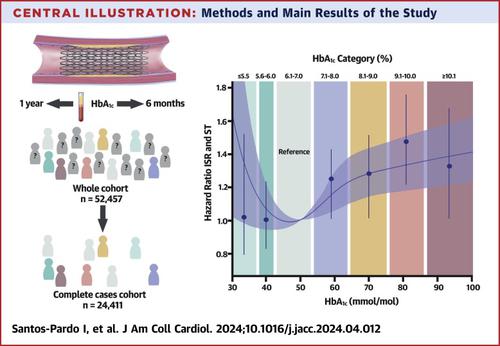当前位置:
X-MOL 学术
›
J. Am. Coll. Cardiol.
›
论文详情
Our official English website, www.x-mol.net, welcomes your
feedback! (Note: you will need to create a separate account there.)
Glycemic Control and Coronary Stent Failure in Patients With Type 2 Diabetes Mellitus
Journal of the American College of Cardiology ( IF 21.7 ) Pub Date : 2024-05-14 , DOI: 10.1016/j.jacc.2024.04.012 Irene Santos-Pardo 1 , Mikael Andersson Franko 2 , Bo Lagerqvist 3 , Viveca Ritsinger 4 , Björn Eliasson 5 , Nils Witt 1 , Anna Norhammar 6 , Thomas Nyström 7
Journal of the American College of Cardiology ( IF 21.7 ) Pub Date : 2024-05-14 , DOI: 10.1016/j.jacc.2024.04.012 Irene Santos-Pardo 1 , Mikael Andersson Franko 2 , Bo Lagerqvist 3 , Viveca Ritsinger 4 , Björn Eliasson 5 , Nils Witt 1 , Anna Norhammar 6 , Thomas Nyström 7
Affiliation

|
The impact of glycemic control in the risk of stent failure in subjects with type 2 diabetes (T2D) is currently unknown. This study sought to study whether poor glycemic control is associated with a higher risk of stent failure in subjects with T2D. This observational study included all patients in Sweden with T2D who underwent implantation of second-generation drug-eluting stents (DES) during 2010 to 2020. The exposure variable was the updated mean of glycated hemoglobin (HbA). Individuals were stratified by glycemic control, with HbA 6.1% to 7.0% (43-53 mmol/mol) as the reference group. The primary endpoint was the occurrence of stent failure (in-stent restenosis and stent thrombosis). The main result was analyzed in a complete cases model. Sensitivity analyses were performed for missing data and a model with death as a competing risk. The study population consisted of 52,457 individuals (70,453 DES). The number of complete cases was 24,411 (29,029 DES). The median follow-up was 6.4 years. The fully adjusted HR was 1.10 (95% CI: 0.80-1.52) for HbA of ≤5.5% (≤37 mmol/mol), 1.02 (95% CI: 0.85-1.23) for HbA of 5.6% to 6.0% (38-42 mmol/mol), 1.25 (95% CI: 1.11-1.41) for HbA of 7.1% to 8.0% (54-64 mmol/mol), 1.30 (95% CI: 1.13-1.51) for HbA of 8.1% to 9.0% (65-75 mmol/mol), 1.46 (95% CI: 1.21-1.76) for HbA of 9.1% to 10.0% (76-86 mmol/mol), and 1.33 (95% CI: 1.06-1.66) for HbA of ≥10.1% (≥87 mmol/mol). Sensitivity analyses did not change the main result. We found a significant association between poor glycemic control and a higher risk of stent failure driven by in-stent restenosis.
中文翻译:

2 型糖尿病患者的血糖控制和冠状动脉支架衰竭
血糖控制对 2 型糖尿病 (T2D) 受试者支架失败风险的影响目前尚不清楚。本研究旨在研究 2 型糖尿病患者血糖控制不佳是否与支架失败风险较高相关。这项观察性研究纳入了瑞典 2010 年至 2020 年间接受第二代药物洗脱支架 (DES) 植入的所有 T2D 患者。暴露变量是糖化血红蛋白 (HbA) 的更新平均值。根据血糖控制对个体进行分层,以 HbA 6.1% 至 7.0% (43-53 mmol/mol) 作为参考组。主要终点是支架失效(支架内再狭窄和支架血栓形成)的发生。主要结果在完整的案例模型中进行了分析。对缺失数据和以死亡作为竞争风险的模型进行了敏感性分析。研究人群包括 52,457 人 (70,453 DES)。完整病例数为 24,411 (29,029 DES)。中位随访时间为 6.4 年。对于 HbA1c ≤ 5.5% (≤37 mmol/mol) 的完全调整 HR 为 1.10 (95% CI: 0.80-1.52),对于 HbA1c 5.6% 至 6.0% 的完全调整 HR 为 1.02 (95% CI: 0.85-1.23) (38- 42 mmol/mol),HbA 7.1% 至 8.0% 时为 1.25 (95% CI: 1.11-1.41) (54-64 mmol/mol),HbA 为 8.1% 至 9.0 时为 1.30 (95% CI: 1.13-1.51) % (65-75 mmol/mol),对于 9.1% 至 10.0% (76-86 mmol/mol) 的 HbA 为 1.46 (95% CI: 1.21-1.76),对于 HbA 为 1.33 (95% CI: 1.06-1.66) ≥10.1%(≥87 mmol/mol)。敏感性分析没有改变主要结果。我们发现血糖控制不佳与支架内再狭窄导致的支架失败风险较高之间存在显着关联。
更新日期:2024-05-14
中文翻译:

2 型糖尿病患者的血糖控制和冠状动脉支架衰竭
血糖控制对 2 型糖尿病 (T2D) 受试者支架失败风险的影响目前尚不清楚。本研究旨在研究 2 型糖尿病患者血糖控制不佳是否与支架失败风险较高相关。这项观察性研究纳入了瑞典 2010 年至 2020 年间接受第二代药物洗脱支架 (DES) 植入的所有 T2D 患者。暴露变量是糖化血红蛋白 (HbA) 的更新平均值。根据血糖控制对个体进行分层,以 HbA 6.1% 至 7.0% (43-53 mmol/mol) 作为参考组。主要终点是支架失效(支架内再狭窄和支架血栓形成)的发生。主要结果在完整的案例模型中进行了分析。对缺失数据和以死亡作为竞争风险的模型进行了敏感性分析。研究人群包括 52,457 人 (70,453 DES)。完整病例数为 24,411 (29,029 DES)。中位随访时间为 6.4 年。对于 HbA1c ≤ 5.5% (≤37 mmol/mol) 的完全调整 HR 为 1.10 (95% CI: 0.80-1.52),对于 HbA1c 5.6% 至 6.0% 的完全调整 HR 为 1.02 (95% CI: 0.85-1.23) (38- 42 mmol/mol),HbA 7.1% 至 8.0% 时为 1.25 (95% CI: 1.11-1.41) (54-64 mmol/mol),HbA 为 8.1% 至 9.0 时为 1.30 (95% CI: 1.13-1.51) % (65-75 mmol/mol),对于 9.1% 至 10.0% (76-86 mmol/mol) 的 HbA 为 1.46 (95% CI: 1.21-1.76),对于 HbA 为 1.33 (95% CI: 1.06-1.66) ≥10.1%(≥87 mmol/mol)。敏感性分析没有改变主要结果。我们发现血糖控制不佳与支架内再狭窄导致的支架失败风险较高之间存在显着关联。











































 京公网安备 11010802027423号
京公网安备 11010802027423号